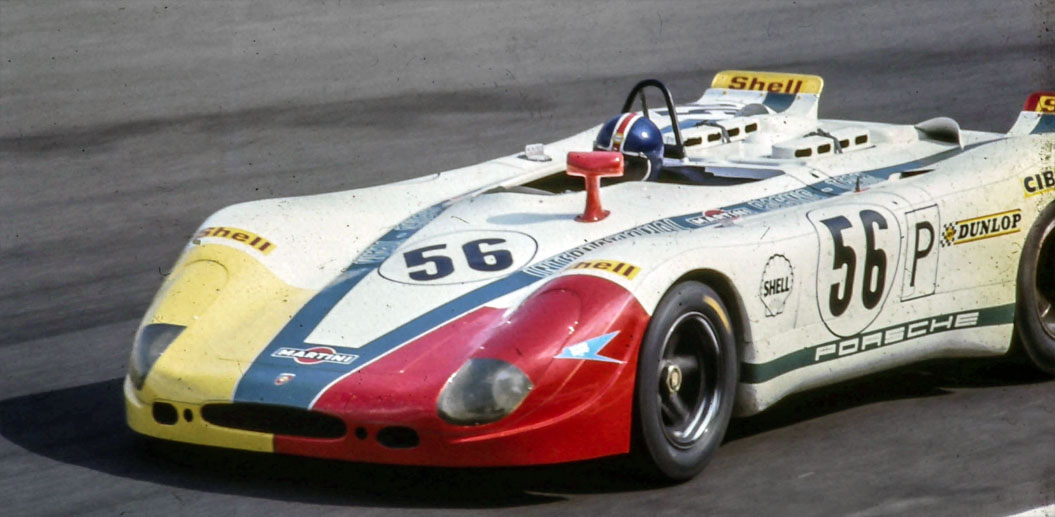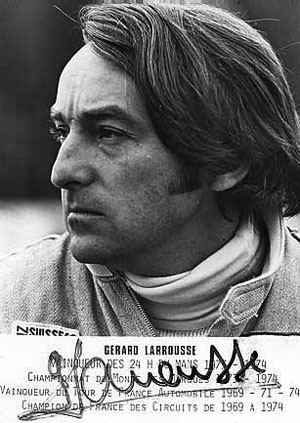Gérard Larrousse (born 23 May 1940) is a former sports car racing, rallying and Formula One driver from France.
After the end of his career as racing car driver, he continued to be involved in Formula One as a team manager for Renault. He later founded and ran his own Formula One team, Larrousse, from 1987 to 1994.
The winner Le Mans 1969, 1973-74. Info from Wiki

Bio by Stephen Latham
This is a long bio but I thought it was only right to include details about his F1 team. Despite the team folding, considering the obstacles it was a great feat to set up the team and keep it running.
Born in Lyon, Gerard Larousse Larrousse studied business management but his passion for rallying disrupted his studies as did his Military service during which he broke both ankles in an accident during a parachute jump.
Although he started in rallying, he would go on to compete in circuit racing, though had a distinguished career on the French national rallying scene. He began rallying in 1961 with a Simca 1300 then switched to a Renault 1100 Dauphine and took his first victory in a French event. In the next two seasons he combined studying with rallying and had some impressive results, winning three French events, including the Lyons-Charbonnieres. He also competed in the Coupe des Alpes with an R8 Gordini.
In 1966 he drove for the Ceida NSU team and finished second in the French Rally Championship, and when Alpine-Renault signed him as a works driver the following year he (and Marcel Callewaert) took eight wins in Alpine A110s and again finished second in the French Championship. In 1968 he raced a 3-litre Alpine (with Patrick Depailler) and finished sixth and ninth in the Paris and Nurburgring 1000 km.
Competing in international rallies, his biggest successes came with a Porsche 911 and he won the Tour de Corse in 1969, was sixth in 1970’s RAC Rally and finished second in the Monte Carlo Rally in 1969, 1970 and 1972.
During this time he and Hans Herrmann took second-place in a Porsche 908 at Le Mans in 1969 and over the next few seasons, he built up a good reputation in endurance racing. He won 1971’s Sebring 12 Hours and the Nurburgring 1000km (with Vic Elford) and won the Tour de France three times, in 1969 (with Maurice Gelin in a Porsche 911), 1971 (with Johnny Rives in a Matra) and 1974 (with J.Rives and Jean Pierre Nicolas in a Ligier). He also won the Marathon de la Route at the Nurburgring in a mid-engined Porsche 914-6.
Also in 1971 he raced a Chevron-Ford B19 and shared a 3-litre Alpina BMW CS with Niki Lauda for part of the Spa 24-hours.
He won four races in 1972 with Lola sports cars and, sharing a Ford Capri with Jochen Mass, they won at Monza and Jarama.
1972 and 1973 also saw him race as a Ford factory driver in touring cars and following this came victories at Le Mans for Matra Simca in 1973 and 1974 (with Henri Pescarolo) plus further victories at Vallelunga, Dijon, the Osterreichring, Watkins Glen, Imola and Kyalami. 1974 could be regarded as his most successful year, achieving twelve victories with Matra or the Archambeaud-ELF factory Renault-Alpine A441. He also won the Targa Florio in a Lancia Stratos and at one point he had scored six international victories in six weekends.
He also made his debut in Formula One this year, driving a Scuderia Finotto Brabham BT42s in two GPS, though retired in Belgium and did not qualify in France.
At the end of the year Matra withdrew from racing and he moved to Alpine for 1975, sharing victory at Mugello with Jean-Pierre Jabouille. That year he established the Elf Switzerland Formula 2 team and he and with J.P.Jabouille driving they won the European F2 Championship. Gerard himself won the Jim Clark Trophy F2 race at Hockenheim, driving one of his own cars.
He then became competitions manager at Renault and oversaw the development of their Formula 1 turbo car, its win in the Le Mans 24 Hours and victory on the Monte Carlo Rally.
He later moved to Ligier and then in 1987 founded the Larrousse F1 team, based in the southern suburbs of Paris, which would compete in Formula One from 1987 to 1994. Drivers who raced for them included Yannick Dalmas, Philippe Alliot, Aguri Suzuki, Pierre Henri Raphanel, Eric Bernard, Michele Alboreto, Bertrand Gachot, Ukyo Katayama, Toshio Suzuki, Érik Comas, Olivier Beretta, Hideki Noda and Jean Denis Deletraz.
The team started in 1987 with just one car for Philippe Alliot, then Yannick Dalmas joined in a second car at the end of the year. For 1989 the team ran Lamborghini V12 engines and P.Alliot remained with them but Y.Dalmas (who had been ill with Legionnaires’ disease) left and was replaced by Éric Bernard and later by Michele Alboreto.
Aguri Suzuki was hired to partner E.Bernard for 1990 and the team moved from Antony to Signes, in the south of France near the Paul Ricard Circuit. 1990 was Larrousse’s best in Formula One and although they had to pre-qualify for the year, Aguri Suzuki scored the team’s first podium at Suzuka in the Japanese Grand Prix, and the team finished sixth in the Constructors’ Championship. Unfortunately, Lamborghini then switched to Ligier so the team used Hart engines in 1991 but early in the year a sponsor, Espo, withdrew and the team struggled financially. That year’s car proved relatively quick and was usually a good midfield runner and A.Suzuki finished sixth in the first race of the season at Phoenix. Eric Bernard had a tough season but took a point with a sixth place finish at the Mexican Grand Prix though he broke his leg in an accident in Japan and Bertrand Gachot returned for the final race in Australia.
In 1991 a major part of the team was sold to the Venturi car company, a new Lamborghini engine deal was agreed and Bertrand Gachot and Ukyo Katayama were their drivers. In 1992 Venturi sold its shareholding to a group called Comstock, headed by Rainer Walldorf. though he turned out to be wanted by the police in connection with four murders. After escaping from a raid on his house in France (actually using a hand grenade), he was killed during a nine-hour gun battle with police.
1993 would prove to be a disappointing season and Philippe Alliot and Érik Comas only had two points scoring finishes. In 1994 they reverted to Ford HB engines and sponsorship from the Danone group saw the cars run in two separate liveries: one in the colours of alcohol-free beer Tourtel where advertising for alcohol products was banned, and the other in the red and white colours of Kronenbourg. On the driver front, Erik Comas was joined by Olivier Beretta though during the season driver changes would see P.Alliot, Y. Dalmas, H.Noda and Jean-Denis Délétraz in the cars.
The team appeared on the entry list for the 1995 season, and though a new car was designed by Robin Herd, it was not built due to lack of funds. It was hoped that Larrousse and DAMS would join to enter the season but they failed to come to an agreement. The hope then was that the French government would give them financial support but within two weeks of the season-opening Brazilian Grand Prix it was announced the would not receive any government money. The team missed the first two races of the season and their situation remained extremely difficult; Ford refused to supply engines without payment and a Petronas sponsorship deal was dependent on them competing in a Grand Prix.Sadly, before the San Marino Grand Prix, Gerard Larousse announced the team was withdrawing from F1.





